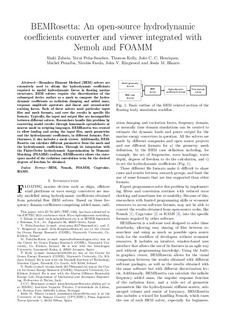Título
Bemrosetta: An open-source hydrodynamic coefficients converter and viewer integrated with Nemoh and FoammAutor-a
Autor-a (de otra institución)
Fecha de publicación
2021Otras instituciones
SENER (Spain)National University of Ireland, Maynooth
Dundalk Institute of Technology
Politecnico di Torino
Universidade de Lisboa
Universidad del País Vasco/Euskal Herriko Unibertsitatea (UPV/EHU)
Versión
PostprintTipo de documento
Contribución a congresoContribución a congresoIdioma
InglésDerechos
© 2021 EWTECAcceso
Acceso abiertoPublicado en
Proceedings of the European Wave and Tidal Energy Conference Editorial
EWTECPalabras clave
BEM
Nemoh
FOAMM
Capytaine ... [+]
Nemoh
FOAMM
Capytaine ... [+]
BEM
Nemoh
FOAMM
Capytaine
HAMS [-]
Nemoh
FOAMM
Capytaine
HAMS [-]
Resumen
Boundary Element Method (BEM) solvers are extensively used to obtain the hydrodynamic coefficients required to model hydrodynamic forces in oating marine structures. BEM solvers require the discretiza ... [+]
Boundary Element Method (BEM) solvers are extensively used to obtain the hydrodynamic coefficients required to model hydrodynamic forces in oating marine structures. BEM solvers require the discretization of the submerged device surface as a mesh to compute the hydro-dynamic coefficients as radiation damping and added mass, response amplitude operators and linear and second-order exciting forces. Each of these solvers need particular input files and mesh formats, and save the results in specific file formats. Typically, the input and output files are incompatible between different solvers. Researchers handle this problem by converting model results through homemade spreadsheets or macros made in scripting languages. BEMRosetta was created to allow loading and saving the input files, mesh geometries and the hydrodynamic coefficients, in different formats. Furthermore, it also includes a mesh viewer. Additionally, BEM-Rosetta can calculate di erent parameters from the mesh and the hydrodynamic coefficients. Through its integration with the Finite-Order hydrodynamic Approximation by Moment-Matching (FOAMM) toolbox, BEMRossetta allows the state- space model of the radiation convolution term for the desired degrees of freedom be obtained. [-]




















